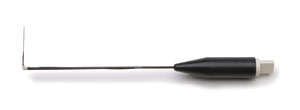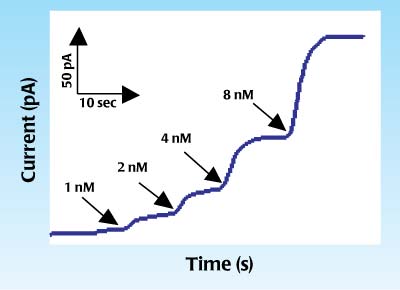

ISO-NOPF100-LXX
ISO-NOPF100-LXX Nitric Oxide Sensor - 100µm
Replace the xx with the desired length between 01 and 10 mm
- Overview
- Specifications
- Accessories
- Citations
- Related Products
Overview

There are 1 images available to view - click to enlarge and scroll through the product gallery.
Instruction Manual
/ Download as PDF
- For use with Apollo1000, Apollo4000, TBR4100 and TBR1025
- Requires cable 91580 (sold separate)
- Response Time: < 5 sec
- Lowest Detection Limit: 0.2 nM
- Sensitivity: 10 pA/nM
- Application: in vivo
- Flexible sensor, nearly unbreakable
L-Shaped sensor for tissue bath studies
The ISO-NOPF100-LXX is a unique L-shaped nitric oxide sensor designed specifically for use in tissue bath studies and similar applications (see WPI's MYOBATH ). The shape of the sensor has been engineered to facilitate placement of the electrode within the lumen of the tissue vessel under study. The ISO-NOPF100-LXX has a flexible tip (100 µm diameter).

Design
These sensors are based on a composite graphite NO-sensing element combined with a reference electrode. The surface of the sensor is then coated with a unique multi-layered NO-selective membrane.
Selectivity of WPI's NO sensors
The ideal NO sensor should be insensitive to other reactive species likely to be present within the measurement environment. Conventional Nafion coated carbon fiber NO sensor exhibits a large response to such species. WPI's unique NO sensor technology utilizes an novel surface membrane which amplifies the response to NO whilst eliminating responses to a vast range of reactive species, including nitrite, absorbic acid, hydrogen peroxide, catecolamines, and much more.
Specifications
| Outside Diameter | 100μm |
| Available Length | 1 to 10mm (replace the XX with the desired length) |
| Response Time | < 5 seconds |
| Lowest Detection Limit/Range | 0.2nM |
| Nominal Sensitivity-New sensor | ≥50pA/nM |
| Baseline Drift | none |
| Poise Voltage | 865mV |
| Typical Quiescent Baseline Current, 25°C | 3500pA |
| Acceptable Baseline Range | 500-8000pA |
| Polarization Time | 8+ hours |




Request
Catalogue
Chat
Print